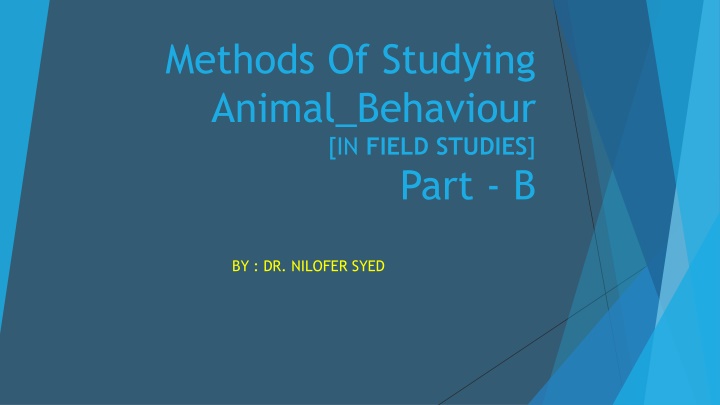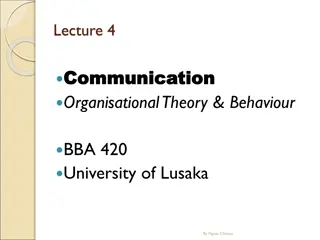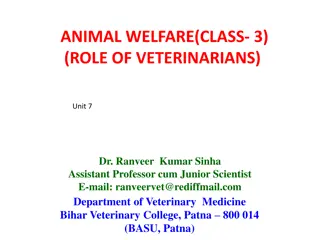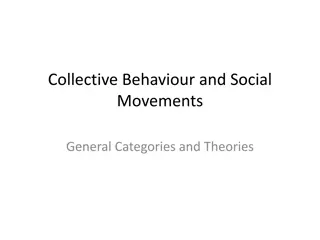
Field Studies: Methods of Studying Animal Behavior
Various methods are employed in field studies to observe animal behavior, such as ad libitum sampling, focal animal sampling, instantaneous sampling, scan sampling, and continuous sampling. Each method offers unique advantages in capturing different aspects of animal behavior, from unrestricted observations to detailed sequences of activities. Researchers like Diana Fossey and Jane Goodall have utilized these methods to gain insights into the behaviors of animals in their natural habitats.
Download Presentation

Please find below an Image/Link to download the presentation.
The content on the website is provided AS IS for your information and personal use only. It may not be sold, licensed, or shared on other websites without obtaining consent from the author. If you encounter any issues during the download, it is possible that the publisher has removed the file from their server.
You are allowed to download the files provided on this website for personal or commercial use, subject to the condition that they are used lawfully. All files are the property of their respective owners.
The content on the website is provided AS IS for your information and personal use only. It may not be sold, licensed, or shared on other websites without obtaining consent from the author.
E N D
Presentation Transcript
Methods Of Studying Animal_Behaviour [IN FIELD STUDIES] Part - B BY : DR. NILOFER SYED
Ad Libitum sampling Ad libitum in Latin means at one s pleasure . A group of animals is selected and the observer remains with this group for a considerable period of time to observe all activities of the group. No constraints are placed as to what should be recorded and when. All behaviours including interactions among the individuals are recorded in field notes. For instance Diana Fossy observed gorillas by living with the group whole day and observing all kinds of behaviour. Because the observer can never keep track of every minute activity of animals, the results of these observations can be biased depending on the situations that attract the observer s attention.
Focal Animal Sampling In this sampling method an individual from a group of animals is selected and all behaviours are recorded for a specified time period. During the specific period, all activities that the animal performs are recorded, while the activities of the other animals of the group are not recorded. After the time period is over, the observer moves to another individual of the group to record its activities. This continues until all animals of the group have been observed for the specified time period. Individuals are identified by marks and named. Jane Goodall conducted such studies on chimpanzees. This method provides unbiased data on a wide variety of questions about the animals and is generally considered most satisfactory approach to studying animal behaviour.
Instantaneous Sampling In this method the observer records the behaviour of an individual in a group at predetermined time intervals, e.g. hourly or half hourly or per minute. The observer records the state of the animal rather than events. The sample interval should be as short as possible and behaviours should be easily identifiable.
Scan Sampling In scan sampling the behaviour of all individuals of a group of animals are recorded at fixed time intervals. This involves rapid scanning of the whole group of subjects at regular interval and behaviour of each individual is recorded. Usually the observer restricts himself to recording of few categories of behaviour. An example of scan sampling would be to observe a group of animals and record the behaviour of each animal per unit of time. This provides data on the distribution of behaviour states in group for a long time period.
Continuous Sampling In this method, the observer simply records all the activities of the animals while they are being watched. This sampling method is very helpful in recording the sequence of activities that make the behaviour, such as courtship display in birds or fighting sequences in deer or moose.
All Occurrence sampling Sometimes certain behaviours are performed by several animals at the same time. For example, one animal starts the alarm call and other animals follow. In such cases the behaviour can be recorded as one event. One can record the number of alarm calls per unit of time, which will provide rate of occurrence of the behaviour in a fixed period of time.
Sequence Sampling In this method, focus is on an interaction instead of on the individuals. The whole sequence is recorded from beginning to end. For example, the aggressive and submissive behaviours can be recorded in social primates. Various types of interactions in social insects such as ants, termites and honey bees can be recorded by sequence sampling.
One-zero sampling Recording of the occurrence is done in Yes or No , depending on the activity performed or not. The results can be presented in frequencies. For example attack behaviour in territorial animals or infant-killing in monkeys.
TRACKING ANIMALS IN THE WILD In order to study the behaviour of animals in their natural environment it is important that the animals are spotted in the wild, identified and studied without disturbing them. Animals can be identified by natural marks such as broken horn or tail, body scars or ear notches. Size and shape of the horns and tusks, facial features or pattern of stripes and spots can also be of help in identification. Photographs can be taken or drawings are made to record the identifications. Wherever it is possible, animals can be captured, marked and then released in the wild for easy identification while studying their behaviour. Ringing of birds is a common method of identifying birds and to trace their migratory route. Fishes can be collected by net, marked and released. Birds can be collected by fog nets which are invisible to the flying birds. GPS tracking systems are used these days to track the animals in the wild, in which animal s movements can be continuously tracked for several days.






















